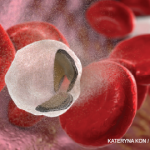Discussion
Evans syndrome is an autoimmune disorder characterized by autoimmune hemolytic anemia and immune thrombocytopenia.2 The disorder is characterized as either a primary, idiopathic syndrome or secondary to another condition, often autoimmune or congenital.3
In 1951, Robert S. Evans, MD, and colleagues reported a series of patients with varying manifestations of anemia and thrombocytopenia.4 In their cohort of 29 patients, they showed five categories of presentation: 1) hemolytic anemia without thrombocytopenia, 2) hemolytic anemia with thrombocytopenia but no purpura, 3) hemolytic anemia with thrombocytopenia and purpura, 4) thrombocytopenic purpura with sensitized red cells, and 5) thrombocytopenic purpura without sensitized red cells and no anemia. Most patients were women. Only one of the patients had systemic lupus erythematosus.
The researchers hypothesized “the activity of an immune body brings about increased destruction of thrombocytes by agglutination and phagocytosis and might also decrease thrombocyte production …,” which may cause Evans syndrome. To date, the pathophysiology of Evans syndrome is not known. Abnormalities in many various immunomodulatory cells have been reported, including alternations in Th1 and Th2.5
Evans syndrome as the initial manifestation of lupus is quite rare, but has been described in a few case reports, particularly in young women.6 In a large, retrospective study of 850 pediatric patients in Brazil, only 1.3% had Evans syndrome at the time their lupus was first diagnosed.7
In another retrospective, single-center study, 2.7% of 953 patients with SLE were also diagnosed with Evans syndrome.2 In this cohort, patients who presented with Evans syndrome as the initial manifestation of SLE had severe, life-threatening multi-organ involvement. This is similar to our patient, who presented with severe anemia and thrombocytopenia.
Symptoms of Evans syndrome include those that are seen typically with anemia, such as fatigue, pallor and dyspnea, and those of thrombocytopenia, namely bleeding, easy bruising and petechiae.8 A high clinical suspicion is imperative for diagnosis. In addition to such basic laboratory tests as complete blood count, diagnostic tests looking for elevated lactate dehydrogenase, low haptoglobin, and peripheral blood smears showing spherocytes can point toward evidence of hemolysis.8
As with many life-threatening rheumatologic conditions, corticosteroids are required at first to rapidly put Evans syndrome into remission. Prednisolone doses range from 1–2 mg/kg/day, and can be up to 6 mg/kg/day.8 Steroids alone, however, are not often enough to place patients into remission, especially those with severe manifestations. A retrospective review showed that of 68 patients with Evans syndrome, only 27% of patients achieved clinical remission with steroids alone.9
Due to a paucity of randomized clinical trials in this rare disease, the choice of second-line immunosuppressive agent in Evans syndrome is often at the discretion of the treating provider. Second-line therapies used for Evans syndrome related to lupus include intravenous immunoglobulin, rituximab, mycophenolate and plasma exchange. Sirolimus and cyclosporine have shown promise in certain cases. Case reports also describe the use of the 26S proteasome inhibitor bortezomib in patients with concomitant lupus, Evans syndrome and antiphospholipid syndrome.10 Danazol, a heterocyclic steroid, has been used successfully in patients, including those with thrombocytopenia refractory to splenectomy. Thrombopoietin receptor agonists, such as romiplostim or eltrombopag, have been anecdotally reported in children with severe, refractory Evans syndrome.8
In particular, rituximab has been shown to have excellent utility in treating lupus-related cytopenias in a multicenter retrospective study. In this study, 71 patients with SLE-associated immune cytopenias were treated with rituximab, with an overall response rate of 86%. In the 10 patients with Evans syndrome related to SLE, the response rate was lower, at 60%, but still favorable. Rituximab was also found to be a safe treatment, with only three of 71 patients developing severe infections and no fatalities.11 This is why rituximab was chosen as second-line therapy in our patient.
The patient was seen approximately two weeks after discharge from the hospital. At this time she was feeling well, and her labs had shown significant improvement, with a hemoglobin of 10.2 g/dL, and platelet count of 185 k/µL. She was started on hydroxychloroquine at that time, prednisone was tapered, and she continued outpatient rituximab infusions through a local hematologist.


